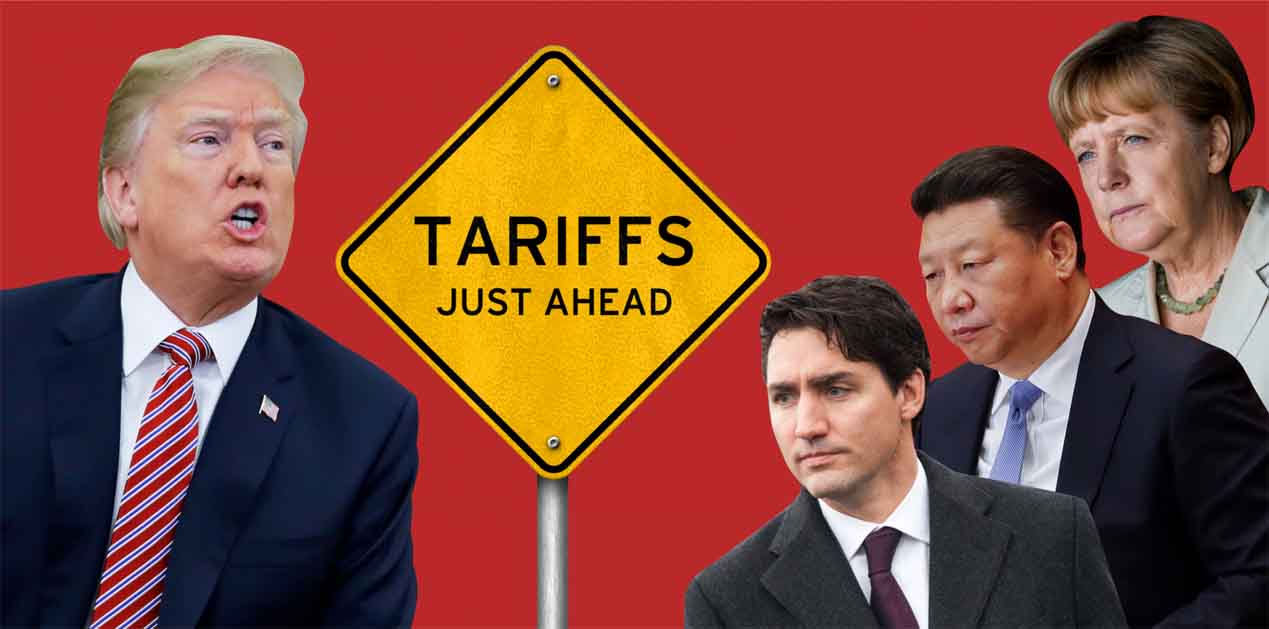The United States, under President Trump, has been at loggerheads with a long list of countries on trade related issues. This includes China, Canada, Mexico and India. The European Union has also suffered. In fact, the Trump administration has used tariffs to punish countries which have not bowed to its demands on issues unrelated to trade too. Most recently the US did this with Mexico to force it to curb illegal immigration into the US from its northern border. India has been in the cross hairs of the Trump administration on trade issues as well. Trump has called India the tariff king, alluding to the barriers India has in place, when importing various products from the developed economies.
The US government slapped tariffs on steel and aluminium imports from India last year. This, though, was not seen as a particularly hostile move in New Delhi as many other countries were also similarly punished by the US. Nevertheless, India retaliated by announcing tariffs on American imports worth $900 million. Recently, Washington has also withdrawn the `Generalised System of Preferences’(GSP) benefits that India accrues when accessing the US market. New Delhi, which had continued to defer the implementation of its announced tariffs on American imports, has now moved to implement them. This points to a breakdown of trade talks between the two countries.
GSP is a World Trade Organisation (WTO) mechanism which allows developed countries to encourage imports from developing states. Under GSP the richer and more industrialised countries give preferential tariff treatment to imports from poorer states. However, the preferential tariff system must not be discriminatory in nature. The recent US action has targeted India and Turkey by withdrawing GSP benefits from the two states. Since the Trump administration’s action is arbitrary in nature, India has the option of dragging the US to WTO on the issue. On the other hand, India has also put up a brave face claiming that the withdrawal of GSP will not affect the country’s exports to the US as only 5 percent of its export portfolio comes under the GSP ambit. New Delhi may be continuing to hold hope of reaching an understanding with the US on its trade and tariff related demands. It may be pinning its hopes on the burgeoning defence and strategic ties between the two countries.
Even as the Trump administration has continued to put overt and covert pressure on India on bilateral trade related matters, it has had minimal effect on the increasingly close defence ties between the two countries. Since the announcement of GSP withdrawal, India has agreed to buy US defence equipment worth more than $3 billion. This includes 24 helicopters for the Indian Navy for approximately $2.4 billion and a missile defence system worth $1 billion. The decision to buy National Advanced Surface to Air Missile System-II (NASAMS-II) is particularly interesting as India already has the SPYDER missile defence systems that is identical in profile to NASAMS-II. This has led to speculation that NASAMS-II is being bought merely to placate the US administration and bridge the trade deficit between the two countries which is loaded in India’s favour.
Moreover, India has agreed to cater to the American demands elsewhere too. After the withdrawal of waivers to the import oil from Iran, India has stopped buying oil from the country completely. This has major implications for India. Oil from Iran came with sweeteners such as free shipping and free insurance. Additionally, Iran is strategically located and India is trying to reach Afghanistan, Central Asia and the Caucasus through Iran. New Delhi now has to forego the economic benefits as well as endanger its strategic interests in the region. It is likely that Iran will put pressure on Indian investments in Chabahar Port to protest against Indian vacillations. In fact, Iranian Foreign Minister Javad Zarif already started making overtures to Pakistan and China by talking of connecting Chabahar to Gwadar on his Pakistan trip recently. India has also refused to buy oil from Venezuela, another country under sanctions from Washington.
However, Indian compliance with the US demands on geopolitical issues have not borne fruit in the trade sector. Washington has continued to push India harder. Recently, news has emerged that India may be put under an internal investigation for its trade practices by the US administration. This is a preliminary step which may lead to wider sanctions against the country. China was put under similar governmental investigation before wide ranging tariffs were slapped on its exports to the US.
The breakdown of trade talks between India and the US is ominous. The American market is the largest in the world. And India is deeply plugged into it. The US is the largest export destination for Indian products. Moreover, a large share of Indian professionals travel to the US and send remittances home. These remittances form a vital component of the Indian economy. At the same time, India is one of the fastest growing large economies in the world. It is the second largest arms importer (as of 2018) and has been increasingly buying weapons from the US. This alone must counteract the voices in the US demanding harsher action against India. In fact, the Indian arms purchases are indicative of the direction of the relationship between the two countries. India and the US increasingly agree on major geopolitical issues in the world. Their vision for the Indo-pacific and their views on the rise of China are in sync. The two countries also agree on anti-terrorism efforts needed in the world. As proof of similar world view, India has agreed to sign the US foundational agreements on military cooperation, the latest of which was COMCASA.
It is not in the interest of either of the states to escalate the trade related challenges into something worse. India needs to stay engaged with the US. On the other hand, New Delhi also needs to impress upon Washington, the unjust nature of US demands. Asking for a reciprocal trade relationship between the largest and most advanced economy and one of the poorer and less developed countries is inherently problematic and unfair. However, for the sake of continuing the rapid growth of its economy, which itself is based on growing trade and which in turn is expected to pull millions of poor citizens of India outside their misfortune, India must continue to ensure that trade between India and the US is not disrupted.
American allies are increasingly frustrated due to the unilateral approach taken by the US under President Trump on a host of issues. This has been most evident after the US withdrew from the Joint Comprehensive Plan of Action (JCPOA) which had been painstakingly negotiated by America`s NATO allies among others. As a result, the JCPOA which was supposed to stop Iran`s nuclear programme is now in a limbo. India has been cooperating with the US in this regard and is paying economic costs for the same. If the US continues to expect Indian cooperation on Iran, it must be ready to give and take on the trade issues. Trade and geopolitics cannot be dealt with as comprising two independent and separate silos.
(Rajesh Soami is an Associate Fellow at National Maritime Foundation, New Delhi)
(The paper is the author’s individual scholastic articulation. The author certifies that the article/paper is original in content, unpublished and it has not been submitted for publication/web upload elsewhere, and that the facts and figures quoted are duly referenced, as needed, and are believed to be correct). (The paper does not necessarily represent the organisational stance... More >>
Image Source: https://www.businessinsider.in/Trumps-trade-war-is-getting-serious-heres-why-it-started-what-it-means-for-the-US-economy-and-how-it-could-hit-you/articleshow/65092628.cms










Post new comment